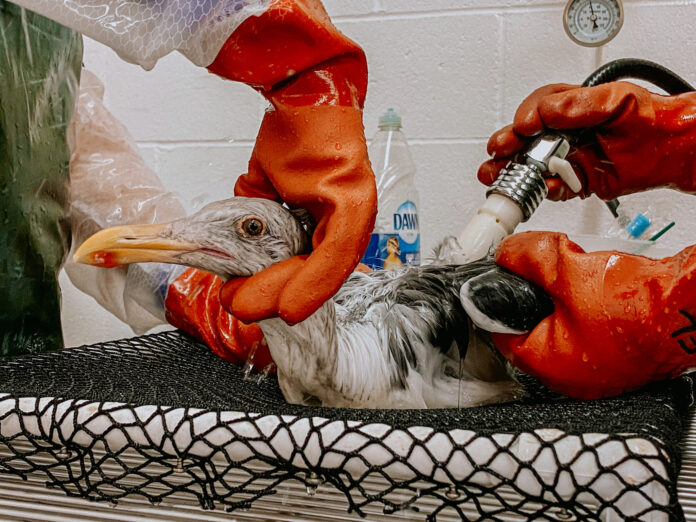Consequences are severe for wildlife when they are not rescued, according to OWCN members
by ELLIE LEE — elelee@ucdavis.edu
Oiled Wildlife Care Network (OWCN) takes initiative in rescuing many living organisms, as a result of the oil spill off Huntington Beach in Southern California. They have saved 31 live birds and one mammal from the oil as of Oct. 14.
When they are rescued, oiled animals are transported to a medical facility, where they go through “intaking & processing” procedures, including a physical exam, and they are given pre-wash care, cleaning in warm soapy water, and conditioning. Dr. Michael Ziccardi, the director of the OWCN, explained how the organization responded quickly to the oil spill.
“The more rapidly we can recover them, the more likely it is they will survive,” Ziccardi said. “That’s one of the reasons why we have so many people trained to be able to respond quickly. We have over 1600 people that are available to us to respond in large scale emergencies. The longer animals are out in the environment without recovering, the less healthy they are.”
On top of saving wildlife that is covered in oil, he discusses how they work with other agencies to be prepared as possible. Trained individuals at UC Davis continue to care for wildlife and to work on preventing damage that might occur from oil spills.
Oiled Wildlife Care Network is guided by four principles: readiness, response, research and reaching out. For readiness, they maintain equipped equipment throughout California, test procedures regularly in exercises and drills and regularly conduct supervisors, volunteers and faculty members.
OWCN recruits professionals and organizations that respond to oil spills. This ensures that they can provide first aid to the organizations and access to at least one of the 12 wildlife rehabilitation facilities.
Members share knowledge with other organizations. They hope to ensure that the world learns about accurate, new information about how oil affects animals.
Network members research, test and explore innovative ways to improve ways to save wildlife; this includes donating over four million dollars to more than 180 scientific studies. In addition, they conduct self-directed research about environmental topics that they find the most concerning.
“UC Davis runs the world’s wildlife Prevention and Response Program,” Ziccardi said. “It’s something I’m proud of. The state should be proud of it, it’s definitely something UC Davis should be very proud of as far as our role in trying to address, saving animals in emergencies such as this.”
Ziccardi is also the executive director of One Health Institute program that addresses health issues between people and the environment, including animals. He directs the California Veterinary Emergency Team, and he teaches free ranging and conservation in the UC Davis Veterinary School.
Kyra Mills, the OWCN senior manager of field operations, explains that OWCN has 44 member organizations as part of the network in the state of California.
“We take them to a rehabilitation center; in this case, the closest center for us is the Los Angeles Oil Bird Care and Education in San Pedro, California,” said Mills. “That’s where the birds collected as part of the spill are being cared for.”
Mills details that the impact of oiling depends on each species affected. The most serious impact is to the animals that depend on their waterproofing to keep warm, according to Mills.
“Seabirds are the most highly impacted,” Mills said. “When oil comes in contact with their fur, it disrupts the feather structure. If it doesn’t have oil in it, it acts as a drysuit and keeps them dryer and warmer when they are in the water.”
She adds that if they are affected by the oil, they stop eating. If they are not rescued, they could die, depending on their species, the amount of oiling and the weather. Large oil spills do not happen too often but small ones happen frequently.
“Not all of them are marine; some of them are impacting in lakes, streams [and] rivers,” Mills said.
Correction: A previous version of this article had an incorrect figure for the number of animals rescued by OWCN. The article has been updated to correct the error.
Written by: Ellie Lee — city@theaggie.org




